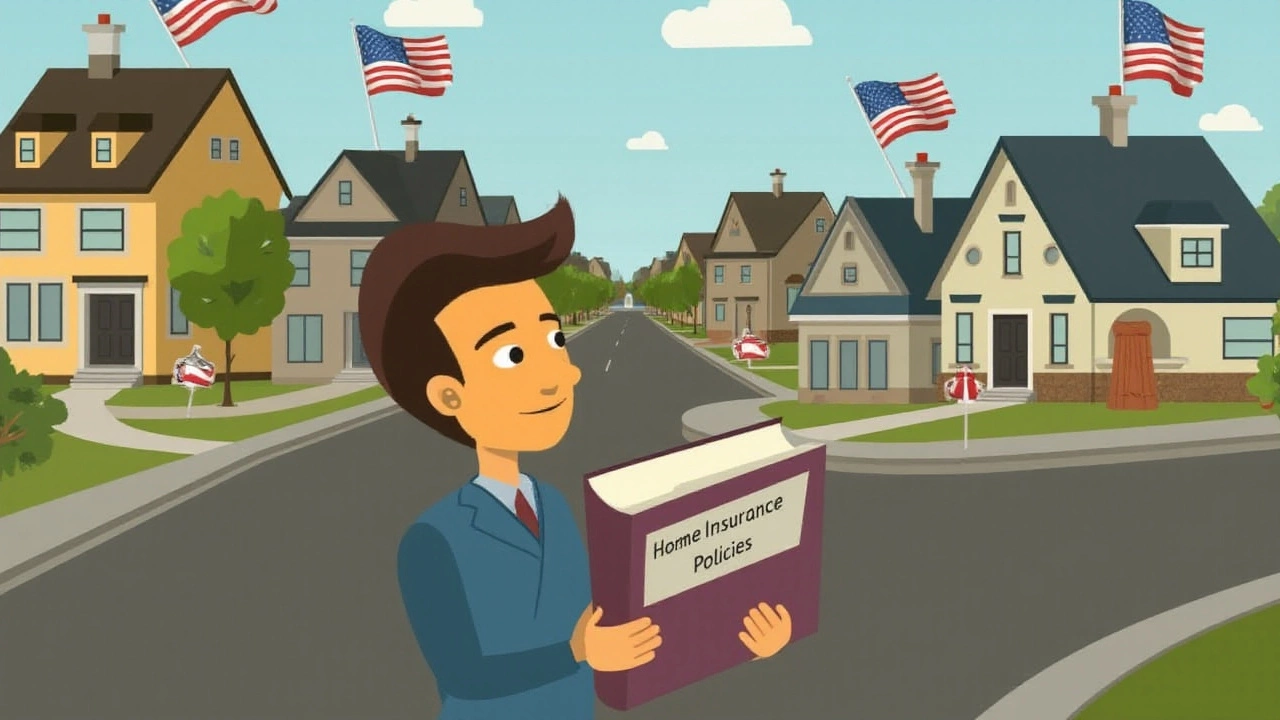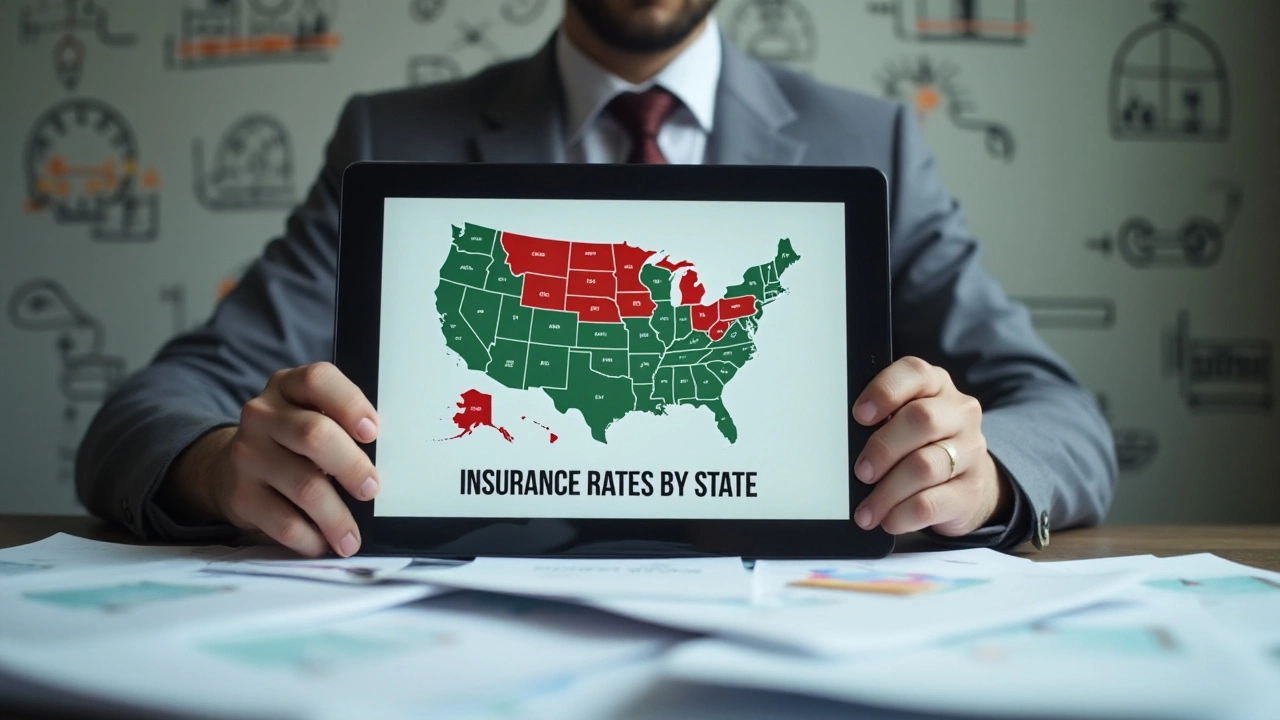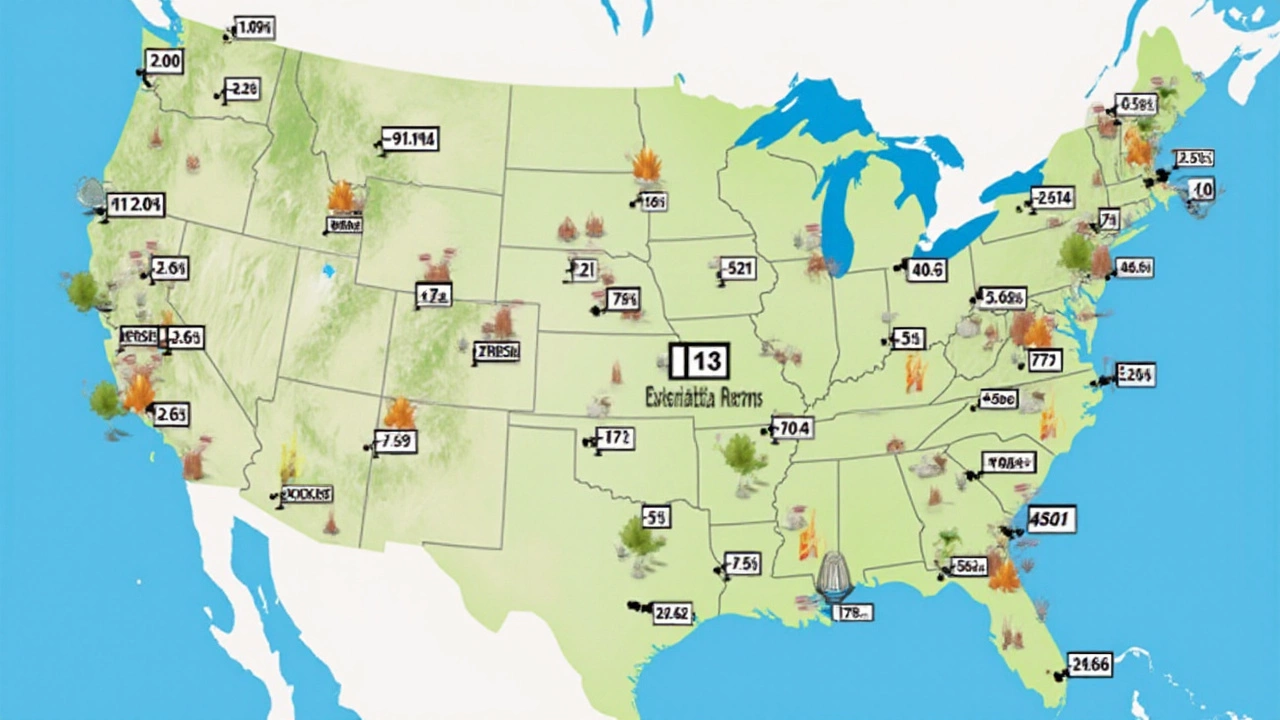Discover the U.S. State with the Highest Home Insurance Costs
 Jan, 17 2025
Jan, 17 2025
Home insurance often feels like a maze wrapped in a web of numbers and fine print. It’s essential, yes, but it can also be perplexing and downright pricey, especially depending on where you live. If you’re curious about which state tops the chart for the most expensive home insurance rates, you’re certainly not alone. This piece sheds light on a pressing issue that affects the wallets of homeowners across America.
Why are some states more expensive than others for insuring your home sweet home? A mix of factors comes into play—from natural phenomena to economic conditions, and even regional laws. And it’s not just about geography; these rates ripple out into financial advice and lifestyle choices for millions. Let's dive into this complex world and come out with a clearer understanding of your home insurance scenario.
- Understanding Home Insurance Rates
- Factors Influencing High Insurance Costs
- The State with the Highest Rates
- Impact of Natural Disasters on Insurance
- Tips for Managing Your Home Insurance
Understanding Home Insurance Rates
Home insurance rates are a topic that every homeowner should grasp deeply, given how much these costs can fluctuate. When you start dissecting the components of a typical home insurance policy, it becomes apparent why prices range so prominently. Insurance isn't just about safeguarding a building's value; it's also about understanding the wider parameters involved. It involves coverage for potential damages, liability protection, and even additional living expenses. The multifaceted nature of insurance means that insurers accumulate extensive data to calculate risk. As the risk grows, so does the premium, and this calculation is not uniform across the board, making geography a critical marker.
State regulations and local laws significantly influence insurance premiums as well. Some states implement rigid mandates requiring higher minimum coverage, which in turn leads to elevated costs. For instance, laws requiring hurricane shutters or other specific requirements to reduce risk can alter policy expectations and expenses dramatically. Another factor that weights in is the financial stability of insurance providers in the area, and even the influence of competition among these firms. When the number of providers is scarce, costs are likely to spike in favor of the insurers. The variability in state laws and insurer presence underlines the importance of a localized approach when comparing insurance rates.
According to a respected insurance analyst, "Understanding the different levers that insurance companies pull to determine your rates is key to making better decisions. The more informed you are about these factors, the greater your ability to negotiate or find better rates."
Looking at the specific dynamics that pump up insurance rates, it's worth mentioning the role of **claims history**. The **frequency and severity of claims** in a particular area tell a story about the local risk environment that can't be ignored. Regions prone to natural disasters—think hurricanes in Florida, wildfires in California, or tornadoes throughout the Midwest—pose different challenges and inherent risks. These translate into claims density, which directly influences the insurance rates. Insurers need to intelligently manage their payouts while remaining profitable, which, in turn, silhouettes into the premiums homeowners face. A spike in claims can lead to recalibrated reinsurance costs, eventually snowballing down to the homeowner.
The **structure of your home** also plays into the intricacies of **home insurance rates**. The age and materials of your house can significantly sway your rates. For instance, older homes often come with outdated electrical and plumbing systems that pose higher risks and, consequently, higher rates. Alongside this, newer homes often benefit from more advanced materials and construction techniques that stand stronger against the elements, potentially leading to discounts. Whether a home is built with fire-resistant materials or equipped with state-of-the-art security systems can also factor favorably into reducing insurance expenses.
To better grasp how these factors materialize into the actual insurance costs, an examination of the data behind home insurance helps paint a clearer picture. Here’s a simplified illustration:
| Factor | Influence on Rates |
|---|---|
| Theft and Crime Rate | Higher risk leads to higher rates |
| Proximity to Emergency Services | Availability reduces rates |
| Construction Material | Advanced materials decrease rates |
| Natural Disaster Risk | Increases rates significantly |
As society and technology progress, the factors influencing home insurance rates may shift, but understanding the core elements remains crucial. By knowing what's behind these numbers, homeowners can not only budget effectively but eventually tweak their setups to invite lower premiums. So don’t just settle for the first quote that comes your way—knowing the terrain can lead to meaningful savings in the long run.
Factors Influencing High Insurance Costs
Understanding what drives home insurance rates sky-high is like peeling back the layers of an onion; there are multiple complex dynamics at play. These factors are often intertwined and vary from one state to another, leading to significant differences in insurance costs across the nation. One of the primary influencers is the state's vulnerability to natural disasters. For instance, states along the Gulf Coast are particularly prone to hurricanes, contributing to their generally high insurance premiums. Insurance companies need to buffer against potential massive payouts, and these increased risks get passed down to homeowners.
Yet, natural phenomena aren't the only culprits. Local building costs and construction practices can also magnify insurance expenses. In places where the labor market is tight and materials are pricey, rebuilding costs after damage tend to be higher. This scenario is particularly common in densely populated urban areas or remote regions where shipping goods can add a premium. Equally important is the different regulatory environments across states. In some regions, state insurance departments impose strict rules for underwriting and rating, making it more costly to sell insurance policies. Companies might be required to provide coverage even in high-risk areas without adequate pricing adjustments, influencing the overall cost structure for all home insurance policies.
Impact of Crime Rates
Crime rates in a state or region can also play a critical role. Areas with higher crime statistics typically see increased rates because insurers account for the potential of property damage or theft. This means that even urban areas with a high population density and otherwise lower risks of natural disasters could carry costly insurance premiums due to elevated crime levels. Imagine living in a bustling metropolis with a vibrant neighborhood and the reality is that higher living costs there include insurance considerations.
Moreover, let’s consider the aspect of climate change and how it is subtly crafting its narrative into this mix. Weather patterns are shifting, and states that rarely saw serious natural disasters in the past are now experiencing them more frequently. This unpredictability forces insurers to adapt their pricing as a safeguard against unforeseeable losses. A source from a leading insurance body once remarked,
"The unpredictability of weather events is becoming a significant driver of insurance cost structures, especially as traditionally safe areas are no longer guaranteed that safety."This evolving climate scenario is pushing insurance companies to contemplate future risks much more cautiously, which then reflects in the premium costs.
Details on Competitive Markets and Company Strategies
In addition, the competitive stance of the insurance market in each state can dictate insurance costs. States with fewer carriers might see higher prices due to the lack of competition, as fewer companies means less pressure to keep rates low. Conversely, in a highly competitive market with multiple insurers, prices might be more consumer-friendly as companies fight for market share by offering better deals. However, the drawback is that highly competitive markets may also encourage riskier underwriting practices, which could backfire during widespread disasters.
Looking at these varied factors, it’s no surprise why the disparity in insurance costs between states can be so stark. Housing market trends, economic health, climate predictions, and even local government policies collaboratively shape the financial landscape, ensuring that there's seldom a one-size-fits-all explanation for insurance pricing. As a homeowner, understanding these influences helps you navigate the complicated world of home insurance more effectively.

The State with the Highest Rates
The landscape of home insurance rates across the United States is as varied as the landscape itself, with each state carving its unique path thanks to a blend of climatic, geographical, and economic conditions. But standing tall, or perhaps shivering under its burden, is the state of Florida. Renowned not just for its sunshine and sandy beaches, Florida also holds the dubious distinction of having some of the highest home insurance costs nationwide. The synergy between its idyllic yet volatile climate and growing population presents a complex mosaic of challenges for both insurers and homeowners.
Florida's reputation as a hotspot for homeowners' woes begins primarily with its vulnerability to natural disasters, specifically hurricanes. Each year, from June to November, the Sunshine State braces itself for hurricane season. And history hasn’t spared Florida—Hurricane Andrew in 1992, Wilma in 2005, and Michael in 2018 are just a few tempestuous reminders of nature’s power. The damage from these hurricanes often runs into billions, leaving insurance companies reeling from the heavy payouts. According to a report by the Insurance Information Institute, insurers in Florida have recorded some of the highest loss ratios in the country due to hurricanes. This inevitably drives up the premiums for the average homeowner who finds themselves with little choice but to shoulder these expenses.
The Florida insurance market is also heavily regulated, partly as a safeguard for property owners. This regulatory environment, while beneficial in ensuring fair practices, can complicate the pricing structure of home insurance, pushing rates up. Coverage demands are higher, and the criteria tighter, pushing many householders towards selecting base policies that unfortunately may not cover all their needs. Market volatility further complicates matters—many insurers have abandoned the state altogether, unwilling to risk recurring high losses, which reduces competition and allows remaining insurers to command higher rates.
As Susan Millerick, spokesperson for the Insurance Information Institute, aptly puts it, "Florida illustrates the delicate balance between nature and habitation, with home insurance held at the fulcrum."
Structure and building codes have seen significant changes, especially post-Andrew. While these codes are designed for enhancing durability against storms, they often translate into costlier renovations or new constructions. As a result, these costs get woven into the insurance premiums, escalating them. For instance, the shift towards using impact-resistant windows and reinforced roofs may be beneficial long-term but comes with immediate financial ramifications for homeowners. Adding another layer to this complex scenario, the real estate market in Florida, especially in coastal areas, has experienced a surge. Properties, new or old, have seen a steep rise in valuation, leading to higher insured sums to reflect the current market value, thereby inflating the insurance costs.
Given these high costs, what’s a Floridian homeowner to do? The logical move is to shop smart. With the tangible costs of homeownership continually increasing, Floridians often seek counsel, compare various insurers, and look into bundling their insurance costs with other policies like auto or life insurance, which can sometimes offer marginal discounts. An informed approach gives them a stronger footing in tackling the daunting task of finding affordable yet comprehensive coverage. Industry experts suggest looking beyond the premiums and scrutinizing the specifics of the coverage terms, checking for exemptions, and understanding the deductibles thoroughly. Only through this vigilant methodology can homeowners truly navigate the high seas of Florida’s home insurance landscape.
Impact of Natural Disasters on Insurance
The impact of natural disasters on home insurance rates is both profound and multifaceted. To put it simply, areas that are prone to natural disasters such as hurricanes, wildfires, earthquakes, or floods often face higher home insurance rates. Insurance companies factor in the increased risk of damage or destruction to homes when calculating premiums. This often means that residents living in high-risk areas need to contend with not just the potential devastation from nature's fury but also the financial burden of protecting their property. From the arid, wildfire-stricken lands of California to the hurricane-battered coastlines of Florida, the cost of home insurance reflects the looming threats from these natural catastrophes.
Interestingly, in places like Florida, hurricanes are a recurring menace that doesn't just damage homes; they disrupt lives and the economy. Insurance companies, assessing their risk from these powerful storms, tend to hike up their rates significantly, making Florida one of the states with the highest home insurance costs. Similarly, in locations susceptible to wildfires, such as parts of California, residents may find their insurance rates skyrocketing. What many may not realize is that these rates can fluctuate based on the frequency and severity of such disasters. If a year passes without a major catastrophe, rates might stabilize, but this is often not the case.
"Insurance rates are like a mirror to the environmental challenges we face; they reflect the increasing volatility of our world," remarked an industry expert, shedding light on the dynamic interplay between natural events and financial planning.Additionally, the type of natural disaster can vastly influence the specifics of coverage that homeowners require. For example, standard policies might not include protection against floods, necessitating a separate, and often costly, flood insurance policy. This gap in coverage leaves homeowners scrambling not only to find appropriate protection but also to manage costs that can seem insurmountable.
Moreover, the landscape of home insurance is influenced by technological advancements in predictive modeling and risk assessment. Insurers now use more sophisticated algorithms and data analytics to predict risk more accurately, which can either exacerbate or mitigate rate hikes. These technologies allow for a more tailored approach, offering potential relief or additional burden to homeowners based on their specific circumstances. However, while technology helps in mapping out risk zones, the inherent unpredictability of nature makes this a challenging task, often leading to a 'better safe than sorry' approach by insurers.
As natural disasters become more frequent and severe due to climate change, many industry experts believe insurance rates will continue to climb. With these rising insurance costs, homeowners are left in a precarious position, seeking strategies to mitigate rates without compromising on necessary coverage. Awareness and proactive measures, such as community-driven risk reduction campaigns and personal home resilience improvements, become central in managing and possibly lowering one's insurance expenses. Still, the overwhelming factor remains the unpredictable nature of, well, nature itself.

Tips for Managing Your Home Insurance
Knowing how to effectively manage your home insurance can save you not only money but also stress. One of the first crucial steps is understanding exactly what your policy covers. Dive deep into the details provided by your insurer and make sure you are aware of the terms and circumstances that might lead to a claim denial. It’s not uncommon for homeowners to overlook specific exclusions or limitations, leading to unpleasant surprises down the line. If jargon-laden documents confuse you, consider consulting an insurance specialist who can offer insights and advice on the nuances.
Shopping around can make a substantial difference in finding the best rates. Different insurers evaluate risk factors distinctively, resulting in varied pricing for seemingly identical coverage. Comparison websites are a valuable resource, allowing you to review multiple options side by side without much hassle. But don't just rely on digital platforms; speaking directly to agents can sometimes yield discounts or unadvertised offers. Consistently reviewing your policy and comparing it against others every few years can ensure that you're always getting the best deal possible.
As noted by the renowned insurance expert, Jonathan Weatherton, "The market is never static. Adjustments based on regional risk assessments, legislative changes, or even emerging trends can lead to significant shifts in home insurance premiums."
Increasing your deductible is another strategic move that can lower your premium costs. This option benefits those who seldom file claims, creating long-term savings potential. However, it’s important to realistically assess your ability to pay the deductible out of pocket in emergencies. Balancing the immediate savings on your premium with the financial readiness to handle potential claims is key to an effective strategy.
Consider bundling your insurance policies. Many companies offer considerable discounts for customers who choose to combine home and auto insurance, for instance. This can not only lead to discounted rates but can also simplify management by having all your policies with one provider. The loyalty you show is often reciprocated through additional discounts and more favorable terms when you demonstrate commitment to a single insurer.
Investing in home security can play a dual role. Adding security systems, smoke detectors, or storm shutters not only increase your home’s safety but can also lower your insurance premiums. Insurance companies frequently provide reduced rates if you can demonstrate that your property has added protective measures. Staying informed about what security upgrades are recognized by your insurer can be a valuable way of making sure you not only protect your home but also your pocketbook.
Finally, keep a detailed inventory of your possessions. This accounting of your household goods will be invaluable in the event of a loss, making the claims process smoother and faster. Regular updates to this inventory can ensure that you’re adequately covered and that claims reflect accurate replacement values. Establishing the habit of keeping records assists in creating peace of mind, knowing that even amidst unfortunate events, you are prepared and well-documented.
